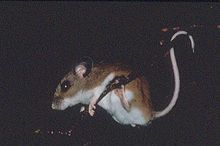Neotominae
| Neotominae | ||||||||||||
|---|---|---|---|---|---|---|---|---|---|---|---|---|

American bush rat ( Neotoma cinerea ) |
||||||||||||
| Systematics | ||||||||||||
|
||||||||||||
| Scientific name | ||||||||||||
| Neotominae | ||||||||||||
| Merriam , 1894 |

The neotominae are a subfamily of the rodent family of agitators (Cricetidae). They are one of the three groups into which the New World mice are divided. The subfamily includes around 125 species that live in North and Central America .
features
The representatives of the Neotominae are outwardly mouse - or rat-like rodents. They reach head body lengths of 5 to 35 centimeters and tail lengths of 4 to 24 centimeters. The weight varies from 6 to 450 grams, depending on the species. Their fur is usually dense, depending on the species, the color varies from yellow to reddish brown and gray to black. The underside is lighter, usually white or light gray. The ears are large, they protrude from the fur and are usually sparsely haired. The tails are usually relatively long. They differ from other New World mice, among other things, in the morphology of the penis .
distribution and habitat
Neotominae are distributed from northern North America ( Alaska , Northern Canada ) via the USA to Central America ( Panama ). They inhabit numerous habitats, including grasslands, forests, deserts, and mountainous regions.
Way of life
Representatives of the Neotominae are often ground dwellers, although some species can climb well and sometimes live on trees. There are also some digging representatives who build underground structures, others construct grass nests on the ground or in the branches. Depending on the species, they can be nocturnal or diurnal and live solitary or in groups. However, little is known about the way of life of many species.
These rodents are herbivores or omnivores. They consume seeds, fruits, stems, nuts, mushrooms and tubers, sometimes supplemented by insects and other invertebrates. The grasshopper mice have specialized in a carnal diet.
Neotominae are often very fertile animals that can have several litters a year. The gestation periods are around 20 to 40 days, the litter sizes one to eleven, but often only two to three. The young are born blind, they open their eyes at two to three weeks and are weaned after three to four weeks.
Systematics
The Neotominae include around 125 species, which can be divided into four tribes with a total of 16 genera:
-
Baiomyini tribe
- American harvest mice ( Baiomys ), 2 species
- Brown mice ( Scotinomys ), 2 species
-
Tribe Neotomini
- American bush rats ( Neotoma ), 22 species
- Magdalena rat ( Xenomys nelsoni )
- Allen's bush rat ( Hodomys alleni )
- Small bush rats ( Nelsonia ). 2 species
-
Ochrotomyini tribe
- Golden mouse ( Ochrotomys nuttalli )
-
Tribe Reithrodontomyini
- Harvest mice ( Reithrodontomys ), 20 species
- White-footed mice ( Peromyscus ), 57 species
- Grasshopper mice ( Onychomys ), 3 species
- Mexican volcanic mouse ( Neotomodon alstoni )
- Florida mouse ( Podomys floridanus )
- Isthmus rats ( Isthmomys ), 2 species
- Thomas deer mice ( Megadontomys ), 3 species
- Habromys . 6 types
- Michoacan deer mouse ( Osgoodomys banderanus )
literature
- Don E. Wilson , DeeAnn M. Reeder (Eds.): Mammal Species of the World. A taxonomic and geographic Reference. 2 volumes. 3. Edition. Johns Hopkins University Press, Baltimore MD 2005, ISBN 0-8018-8221-4 .